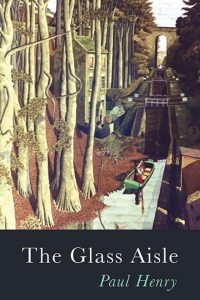The Glass Aisle
 The Glass Aisle enfolds the reader with intricacies and figures of sound, exploring noise, rhythm and also silence within its pages. Addressing time, loss and childhood memories ─ told through the stories of ordinary people ─ the collection’s musicality and its preoccupation with voices make for its signature sonic tapestry.
The Glass Aisle enfolds the reader with intricacies and figures of sound, exploring noise, rhythm and also silence within its pages. Addressing time, loss and childhood memories ─ told through the stories of ordinary people ─ the collection’s musicality and its preoccupation with voices make for its signature sonic tapestry.
This is the tenth book of poetry from Paul Henry, a singer-songwriter. There is a performance version of The Glass Aisle, in collaboration with Brian Briggs, which has been touring at the time of publication.
Nostalgia in this collection is obvious from the very first page where Henry writes about clouds full of his mother’s songs moving east (‘Cliff Terrace Clouds’). The nostalgia soon becomes the collection’s underlying theme, not due to its prevalence, but the subtlety of Henry’s language, making the mood feel natural, not forced:
As if she might still save
the trees from themselves
on the towpath, my wife
is pinning back the leaves.And for every leaf returned
another falls to the ground,
to the colours of heartbreak,
of clothes she used to make.(‘The Seamstress’)
Yet Henry’s silences, which succeed sounds in the poems, are often more meaningful, yielding metaphors that stay with the reader for a long time. Perhaps the most striking example can be found in ‘Chainsaws in the Mist’:
Another man’s scream
tries to cut a way out.[…]
Across the white silence
our chainsaws scream.
In this poem about grief, loss and helplessness, Henry uses sound and lack thereof to build a place where emotions are contained within the walls of silence or unbearable noise. In The Glass Aisle, these two have a lot in common, so distinguishing them requires attention to every moment:
the bow
half-touching the stringa beat before the singer sings.
(‘The Hesitant Song’)
The collection is split into three parts, with the second one almost entirely dominated by ‘The Glass Aisle’, the centrepiece of the collection. Across eleven pages, Henry tells a story of shifting seasons, melting generations, people who used to live in a workhouse by the canal. There are John Moonlight, a Victorian poacher, and Mary Thomas, abused as punishment for her son crying in the chapel, her pain depicted in two short, striking lines:
The canal is inside me now.
Its arches rig my spine.
Countless other names give the poem its rhythm, the staccato of generations coming and going. The ghosts of these voices are heard by an engineer working on a telegraph pole by the canal, the pole then becoming his prison:
He has been up there for a year,
too high to engage in small talk
as he strains to hear lost voices […]
The titular glass aisle is canal in the winter, the frozen water breaking with the weight of John Moonlight when he walked over it, causing his death.
The water came up to his heart…
[…]
And in his eyes… not terror
but disbelief that it could give
beneath him, as they cheered […]
‘The Glass Aisle’ is a remarkable poem, the characters recurring in novel settings, time and status as only an illusion. Henry is a master of reusing lines, characters, building upon previous iterations. For example, this powerful line that appears in the middle of the poem returns slightly changed at its end, still containing all of its suggestion of freedom and majestic beauty:
Each nib’s calligraphy
scratches on stone, on glass, in airI was never so free.
Henry’s latest collection is worth reading for the titular poem alone, but The Glass Aisle as a whole is remarkable. Each poem and each reading feels like a homecoming albeit using a different door.

Leave a Reply